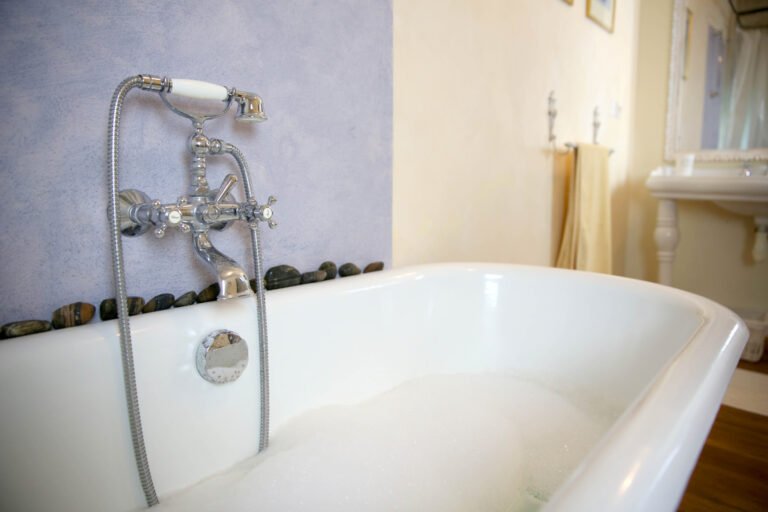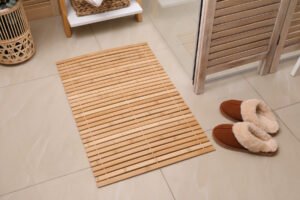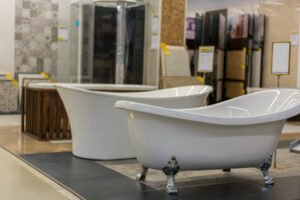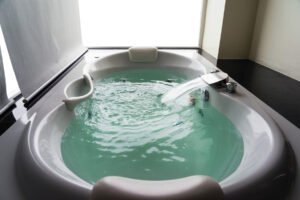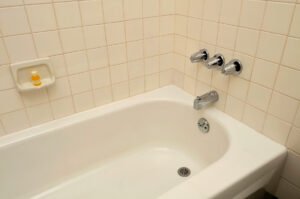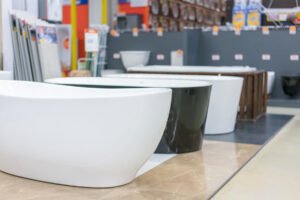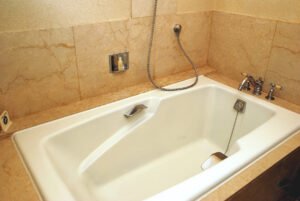A bathtub faucet is one of the most functional hardware fittings of any bathtub. These pipe-like taps regulate water flow in the bathtub and add a chic statement to your overall bathroom decor.
Though faucets are comparatively smaller fixtures, they can make or break your bathroom design and functionality. But since thousands of faucets are available in the market, you must know their key features, operations, and finishes to make the right choice.
So, today, we bring you this guide on different bathroom faucets based on their styles, spacing, materials, and installation, along with some primary features and tips to make selection easier.
What is a Bathtub Faucet?
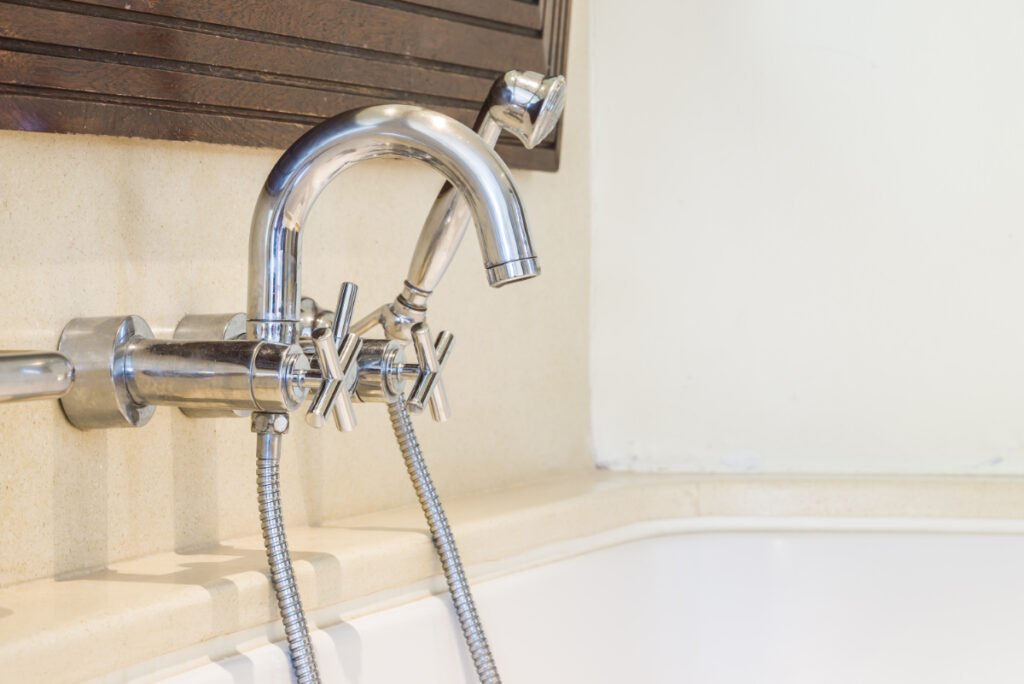
A bathtub faucet is a plumbing fixture with an in-built water pressure system that directs water flow out of the faucet spout. Its angular and high-end design ensures a smooth water supply and restricts the upward flow of water, thus maintaining proper pressure and equilibrium in your plumbing.
How to Choose the Right Bathtub Faucet for Your Bathtub?
Bathtub faucets have several variations in their finish, material, installation, and number of holes and spacing, and each one of them will curate a different look with different types of bathtubs, bathtub materials, and bathroom interiors.
So, we highlighted some essential elements to help you pick the best bathtub faucet for your tub.
- Bathroom Design & Interior: Analyze the era and decor style of your bathroom, bathroom sink, and bathtub, and pick a faucet in the same design style for a cohesive look.
- Number of Holes: Check the number of faucet holes drilled in the bathtub and pick one-holed, two-holed, or three-holed faucets accordingly. If you have softer enamel bathtubs that might wear away with drilling, select a freestanding or wall-mount faucet.
- Accessories: Pick advanced bathtub faucets with anti-scald protection or valves if you have young children who might misuse them and harm themselves.
- Material: The bath faucet’s material affects its overall durability, lifespan, and wear and tear. Generally, metal bathtub faucets like chrome or brass last much longer than zinc or plastic ones, which can break easily with continuous use.
- Cost: Costing is necessary for faucet selection, especially if you are on a budget. Generally, durable metal faucets cost about $100 per piece, whereas zinc ones are comparatively cheaper and cost about $25-30 per faucet.
Types of Bathtub Faucets Based on the Installation
1. Deck Mounted Faucet
Where to use: You can use them for Japanese-style tubs, Alcove tubs, Soup-bowl tubs, and built-in shower tubs with a deck.
Deck-mounted faucets connect to porcelain, wood, or stone decks on the bathtub edges. These faucets allow sufficient operating and rotating space for each faucet and handle.
Moreover, they are easy to install and can be repaired or replaced easily without disrupting the existing plumbing lines, but they are comparatively pricey and fragile.
What do we like about them?
- It attaches to a deck present on the sides of the tub, and you don’t need to drill any holes in the bathtub surface.
- They give a timeless look with high spot ends and various handle styles that seamlessly fit any decor.
2. Wall Mounted Faucet
Where to use: They are ideal for smaller corner tubs, alcove tubs, jacuzzi tubs, spas, under-mount tubs, and hot tubs.
These faucets are directly mounted on the bathroom walls and require no additional drilling and fixing to the bathtub. Moreover, they are the most affordable option and can be entirely concealed in the walls with only the long bathtub spout and handle showing outwards.
Plus, they come in various vintage and ultramodern finishes to suit your decor style.
What do we like about them?
- They save the extra drilling on the bathtub surface and create more space.
- You can plug them into a handheld shower using a diverter valve.
3. Floor Mounted or Free-standing Faucets
Where to use: Use them for a free-standing tub, clawfoot tub, soup-bowl tub, or an oversized, central alcove tub or bathroom sink.
Floor-mounted faucets have a large faucet handle that runs from the bathroom floor to the bathtub ledge, curves, and rises slightly above it. Though these are a bit pricier, they allow you to place the bathtub wherever you want and draft exposed piping that can be painted, designed, and curated as a style statement.
However, repairing the tub spout of a floor-mounted faucet is extremely tricky, and you may have to remove the floor tiling or drill a hole in the bathroom floor.
What do we like about them?
- Give a post-modernist, sleek and streamlined look.
- Allows you to place the bathtub wherever you want without any need for supporting walls or edges.
4. Tub Wall Mount Faucets
Where to use: Use them for stronger stone, wood, or metal tubs that withstand heavy drilling and installation.
Tub wall mount faucets have a shorter tub spout and handle that sticks out right from the tub wall and maintains a waterfall-like waterflow that suits deeper soaking tubs.
However, installing them is tricky; you may require professional help and a diverter valve to do so efficiently. Plus, these faucets give a vintage look and might not suit modern bathrooms.
What do we like about them?
- Adapt well to the complex plumbing of freestanding or standalone tubs.
- Maintain a continuous shower-like flow without an additional shower faucet.
Types of Bathtub Faucets Based on the Mounting Holes
5. Single-Hole Bathtub Faucet
Prominent Materials: Copper, Stainless Steel, Polished Nickel, and Other Metals.
A single-hole faucet has a single tub spout and a rotating handle that gives cold water when turned to the right and hot water when turned to the left. Besides, it has a single hole that makes installation easy and inexpensive, saving time, money, and additional fixtures. These faucets have broader spouts that do not rust easily and last a long time.
Typical characteristics:
- Surface-mounted and easy to install, repair or replace.
- Waterfall-like water flow and a spout with a shiny, chrome faucet finish.
6. Three-Holed Bathtub Faucets
Prominent Materials: Polished Chrome, Solid Brass, Bronze, or Nickel.
Three-holed faucets have a single tub spout but have two more mixing taps for hot and cold water, allowing you to control the water temperature and flow precisely. However, these are prone to leaks and need additional maintenance or anti-rust treatments to last longer.
Moreover, extra accessories like a soap dispenser or hand shower will need separate holes and cannot connect with the main faucet design.
Typical characteristics:
- It is tricky to install and requires help from a professional plumber.
- Allows you to mix hot and cold water as per your need and for optimal comfort.
- It comes with a slender, long spout with a high water flow.
Types of Bathtub Faucets Based on Spacing
7. Centerset Spread Bathtub Faucets
Where to use: Ideal for cramped bathrooms, smaller corner tubs and spas, jacuzzis, and spas.
Centerset bathtub faucets consist of a short tub faucet and two closely located mixer taps, about 4-inches apart from each other, that operate as a single functioning unit. Moreover, they come with a relatively broader but shorter stout that saves space without compromising efficiency and maintains a uniform water pressure.
8. Mini Spread Bathtub Faucets
Where to use: Ideal for maintaining uniform water flow in a smaller alcove tub, clawfoot tub, or bathroom sink.
Mini spread tub faucets have a long, slender spout and have three mixer taps, placed about 7-8 inches from each other for hot, cold, and warm water, respectively. They also have an attached spray or hand shower head and function as a whole for all your needs. Moreover, they come in various modern and traditional finishes for timeless decor.
9. Widespread Faucet
Where to use: Recommended for more extensive, luxurious bathroom faucets and standalone tubs.
Widespread bathroom faucets have a larger and broader spout body and come with 2-3 mixer taps, placed at a distance of more than 12 inches from each other. These achieve a more modern and eclectic look and provide ample space to install other supporting accessories like hand showers or soap dispensers.
Types of Bathtub Faucets Based on Design Style
10. Roman Tub Faucet
Decor Style: Roman traditional, New-classical, or Colonial.
Roman bathtub faucets have a traditional, broader yet shorter spout that mimics the colonial baths of ancient Rome. These faucets feature a signature arched body that combines the experience of hot baths and showers into one.
Further, they are available in deck-mount, floor-mount, and wall-mount styles. Plus, the faucet looks luxurious and revamps your decor on a budget.
What do we like about them?
- It can easily match existing fixtures and oddly shaped bathtubs.
- They are available in various finishes – oil-rubbed bronze, brushed nickel, and copper to suit different bathtub finishes.
11. Waterfall Faucets
Decor Style: Industrial, Modern or Contemporary, and Eclectic.
Waterfall faucets have expansive spouts that produce a sheet-like waterflow, similar to a cascading waterfall. They have a crisp, geometric body with high-tech sensors that operate the faucet based on the surrounding movement.
Moreover, they come in deck mount, wall mount, and floor mount models, and you can pick one that suits your bathtub position.
What do we like about them?
- Uniform and heavy water flow that fast fills deeper soaking tubs and hot tubs.
- It gives a high-end, ultramodern look to simple bathtubs and is low maintenance.
12. Spout-Only Bathtub Faucet
Decor Style: Transitional, Futuristic, and Zen.
Spout-only faucets are a great option to modernize the spouts of your existing faucets without changing the overall plumbing and handles. These not only improve the water flow in the bathtub, but the sturdy rectangular spout upgrades the look of your fixture and enhances its durability.
What do we like about it?
- Upgrades the spout in a cost-effective way.
- Allows greater water flow and offers a higher warranty.
- Easy installation, repairs, and replacement.
13. Vintage Bathroom Faucet
Decor Style: Traditional, Baroque, Colonial, or Victorian.
Vintage tub faucets come with a shorter, broader spout, connected mixer taps, and a hand shower sprayer that hangs from an ambulatory wire. Moreover, the mixer taps have traditional, rotating knobs, similar to the rotary phones of the Victorian era, and thus, ooze a conventional ambiance and a dominant aesthetic.
What do we like about them?
- Manually operated and have no risk of malfunctioning.
- Every unit connects to the main wall faucet, thus eliminating the risk of falling and breaking.
14. Spout Faucet With Diverter Valve
Decor Style: Transitional, New-classical, Classical, and Zen.
These types of faucets have a small knob, handle, or concealed pull on the spout surface that splits the flow of water between the spout and the shower, thus maintaining proper equilibrium in your piping.
Furthermore, you can pair it with a simple bar shower or filtered shower for a retro-like look or add solid brass finishes to look more transitional.
What do we like about it?
- Controls both the faucet and the shower via a single knob.
- Affordable and easy to install.
- Saves space.
Types of Bathtub Faucets Based on the Handles and Operation
15. Single Handle Bathroom Faucet
Where to use: Ideal for a small corner tub, alcove tub, walk-in tub, or as a bathroom sink faucet.
A single-handle faucet uses a single, rotating handle that twists to the right, left, or goes above the spout to supply hot, cold, and warm water. Moreover, it saves space and doesn’t require much drilling and screwing during installation.
Additionally, it is sturdy, durable, at a lower risk of leakage, and can last a long time with regular maintenance and cleaning.
16. Bridge Faucet
Where to use: Use it as a smaller bathroom sink faucet, corner tub faucet, or walk-in tubs and spas.
The bridge faucet has two separate handles, one each for hot and cold water, joined by a sleek, bridge-like design that mixes the water to the correct temperature and directs it to the main tub filler.
Further, the faucet provides enough room to add accessories like soap dispensers and hand showers to the tub filler trim without any overload.
Types of Bathtub Faucets Based on the Material
17. Solid Brass
Surprisingly, brass tub fillers are more durable and long-lasting than most faucet materials and exude a shiny metal finish that suits traditional and modern bathrooms alike.
You can also plate them with a golden or oil-rubbed bronze polish for a more luxurious feel. Overall, brass resists corrosion, wear, and tear and is suitable for day-to-day use.
18. Stainless Steel
Stainless steel faucets do not rust easily. Additionally, they don’t dent even with rough use and are the right tap if you have small children. However, steel faucets show hard water, detergent, or soap stains quickly and require regular oiling and polishing to maintain their silvery shine.
Rinse your steel faucet with any non-abrasive cleaner or dish soap once a week to maintain its polish and shine for a long time.
19. Zinc
Zinc faucets are affordable, lightweight, and easy to install and use. But they are very brittle and cannot take heavy screwing and drilling. Besides, they have a dull shine and need a secondary top coat of brass or polished chrome to look more polished and modern.
Lubricate your zinc faucets with a silicone-based lubricant or oil them regularly to reduce friction and make them last longer.
20. Plastic
Plastic or polyethylene faucets are great cost-savers and offer a chic look with a new-classical design. These use cross-linked plastic fibers for the faucet body and do not wear out and chip like standard plastic.
Additionally, their transparency reveals all the areas of mold or fungi accumulations, and you can clean them before further damage.
Never use vinegar, bleach, or harsher abrasive cleaners to clean your plastic faucets, as they may add a whitish stain and decolor them.
21. Polished Chrome
Chrome faucets look stylish and come in various colors and finishes that adapt to different bathroom decor designs. But remember, they are not durable and may cause higher upfront and replacement costs.
Clean the faucet aerator with vinegar or soap to remove all the salts, mineral deposits, and buildup for optimal water flow and functioning.
22. Nickel
Nickel faucets are expensive and difficult to maintain, but they are much more durable, lightweight, and long-lasting than any other metal faucets. These faucets also add a rich, darker, and dynamic faucet finish that looks luxurious, trendy, and high-end.
Moreover, they suit traditional and modern bathroom styles and are the right tools for a shimmery zing.
Never use scouring pads or stainless steel sponges to clean your nickel faucet, as it can damage its shine and scratch the surface.
What Is the Best Finish for Your Bathtub Faucet?
Although the best faucet finish depends on the material, style, and look you want, you can use simple chrome finishes for a rigid, scratch-resistant surface for daily use. You can even use solid brass or nickel finishes for traditional bathrooms, but they are a little pricey and might look dull in poorly lit bathrooms.
On the other hand, brushed or matte metal finishes can be used for rustic farmhouse-style or heavy-use bathrooms while highly polished, glossy metallic finishes can be used for industrial and modern tub fillers.
How Long Does a Bathtub or Bathroom Sink Faucet Last?
Bathtub faucets typically last for 15-20 years when installed correctly by a professional and on regular maintenance. Of course, their lifespan depends on how you use them and the quality of water and faucet material, but most tub fillers would last for a minimum of 10 years.
How to Remove the Hard Water Stains from Your Faucet and Make It Shine Again?
Cleaning hard water stains is relatively easy, and you just need to wet a soft, microfiber cloth or rag with vinegar, place it over the spout for about 30 minutes, and create a tight seal with a rubber band. Vinegar will loosen all the accumulated calcium deposits and restore your faucet finish in no time.
How Much Does It Cost to Repair a Bathtub Faucet?
Bathtub faucet repairs will cost about $300-400 for simple repairs but may escalate to $1500-2000 to replace the whole plumbing or faucet. On the other hand, tub spout replacements are much cheaper and may cost about $100 per piece.
A bathtub faucet is undoubtedly an essential fixture for any functional bathtub. It regulates the flow, temperature, pressure, and aeration of water for optimal comfort. Different types of faucets suit different bathroom decors, and some can even be used with different bathtub alternatives.
And we hope our guide has made things easy and helped you pick the right faucet.
Now that you have your dream faucet, it’s time to maintain it properly to ensure a smooth water flow. One way to do this is by using the right bathtub drain stopper!

